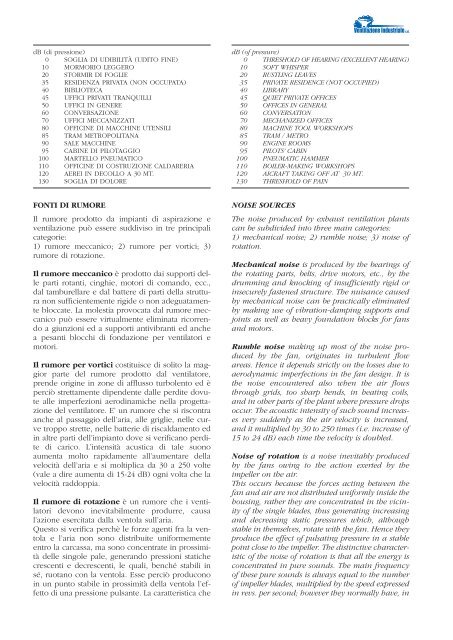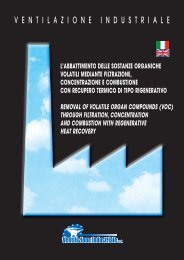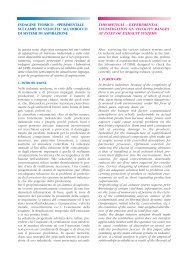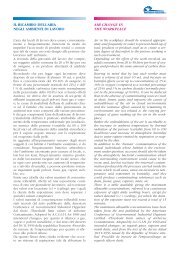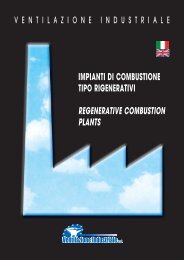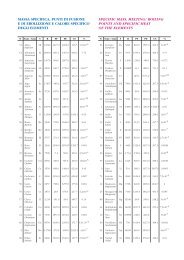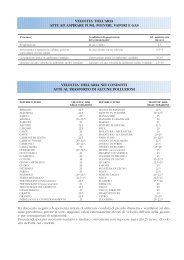IL RUMORE NEGLI IMPIANTI DI ASPIRAZIONE E VENTILAZIONE ...
IL RUMORE NEGLI IMPIANTI DI ASPIRAZIONE E VENTILAZIONE ...
IL RUMORE NEGLI IMPIANTI DI ASPIRAZIONE E VENTILAZIONE ...
You also want an ePaper? Increase the reach of your titles
YUMPU automatically turns print PDFs into web optimized ePapers that Google loves.
dB (di pressione)<br />
0 SOGLIA <strong>DI</strong> U<strong>DI</strong>B<strong>IL</strong>ITÀ (U<strong>DI</strong>TO FINE)<br />
10 MORMORIO LEGGERO<br />
20 STORMIR <strong>DI</strong> FOGLIE<br />
35 RESIDENZA PRIVATA (NON OCCUPATA)<br />
40 BIBLIOTECA<br />
45 UFFICI PRIVATI TRANQU<strong>IL</strong>LI<br />
50 UFFICI IN GENERE<br />
60 CONVERSAZIONE<br />
70 UFFICI MECCANIZZATI<br />
80 OFFICINE <strong>DI</strong> MACCHINE UTENS<strong>IL</strong>I<br />
85 TRAM METROPOLITANA<br />
90 SALE MACCHINE<br />
95 CABINE <strong>DI</strong> P<strong>IL</strong>OTAGGIO<br />
100 MARTELLO PNEUMATICO<br />
110 OFFICINE <strong>DI</strong> COSTRUZIONE CALDARERIA<br />
120 AEREI IN DECOLLO A 30 MT.<br />
130 SOGLIA <strong>DI</strong> DOLORE<br />
dB (of pressure)<br />
0 THRESHOLD OF HEARING (EXCELLENT HEARING)<br />
10 SOFT WHISPER<br />
20 RUSTLING LEAVES<br />
35 PRIVATE RESIDENCE (NOT OCCUPIED)<br />
40 LIBRARY<br />
45 QUIET PRIVATE OFFICES<br />
50 OFFICES IN GENERAL<br />
60 CONVERSATION<br />
70 MECHANIZED OFFICES<br />
80 MACHINE TOOL WORKSHOPS<br />
85 TRAM / METRO<br />
90 ENGINE ROOMS<br />
95 P<strong>IL</strong>OTS' CABIN<br />
100 PNEUMATIC HAMMER<br />
110 BO<strong>IL</strong>ER-MAKING WORKSHOPS<br />
120 AICRAFT TAKING OFF AT 30 MT.<br />
130 THRESHOLD OF PAIN<br />
FONTI <strong>DI</strong> <strong>RUMORE</strong><br />
Il rumore prodotto da impianti di aspirazione e<br />
ventilazione può essere suddiviso in tre principali<br />
categorie:<br />
1) rumore meccanico; 2) rumore per vortici; 3)<br />
rumore di rotazione.<br />
Il rumore meccanico è prodotto dai supporti delle<br />
parti rotanti, cinghie, motori di comando, ecc.,<br />
dal tamburellare e dal battere di parti della struttura<br />
non sufficientemente rigide o non adeguatamente<br />
bloccate. La molestia provocata dal rumore meccanico<br />
può essere virtualmente eliminata ricorrendo<br />
a giunzioni ed a supporti antivibranti ed anche<br />
a pesanti blocchi di fondazione per ventilatori e<br />
motori.<br />
Il rumore per vortici costituisce di solito la maggior<br />
parte del rumore prodotto dal ventilatore,<br />
prende origine in zone di afflusso turbolento ed è<br />
perciò strettamente dipendente dalle perdite dovute<br />
alle imperfezioni aerodinamiche nella progettazione<br />
del ventilatore. E’ un rumore che si riscontra<br />
anche al passaggio dell’aria, alle griglie, nelle curve<br />
troppo strette, nelle batterie di riscaldamento ed<br />
in altre parti dell’impianto dove si verificano perdite<br />
di carico. L’intensità acustica di tale suono<br />
aumenta molto rapidamente all’aumentare della<br />
velocità dell’aria e si moltiplica da 30 a 250 volte<br />
(vale a dire aumenta di 15-24 dB) ogni volta che la<br />
velocità raddoppia.<br />
Il rumore di rotazione è un rumore che i ventilatori<br />
devono inevitabilmente produrre, causa<br />
l’azione esercitata dalla ventola sull’aria.<br />
Questo si verifica perchè le forze agenti fra la ventola<br />
e l’aria non sono distribuite uniformemente<br />
entro la carcassa, ma sono concentrate in prossimità<br />
delle singole pale, generando pressioni statiche<br />
crescenti e decrescenti, le quali, benché stabili in<br />
sé, ruotano con la ventola. Esse perciò producono<br />
in un punto stabile in prossimità della ventola l’effetto<br />
di una pressione pulsante. La caratteristica che<br />
NOISE SOURCES<br />
The noise produced by exhaust ventilation plants<br />
can be subdivided into three main categories:<br />
1) mechanical noise; 2) rumble noise; 3) noise of<br />
rotation.<br />
Mechanical noise is produced by the bearings of<br />
the rotating parts, belts, drive motors, etc., by the<br />
drumming and knocking of insufficiently rigid or<br />
insecurely fastened structure. The nuisance caused<br />
by mechanical noise can be practically eliminated<br />
by making use of vibration-damping supports and<br />
joints as well as heavy foundation blocks for fans<br />
and motors.<br />
Rumble noise making up most of the noise produced<br />
by the fan, originates in turbulent flow<br />
areas. Hence it depends strictly on the losses due to<br />
aerodynamic imperfections in the fan design. It is<br />
the noise encountered also when the air flows<br />
through grids, too sharp bends, in heating coils,<br />
and in other parts of the plant where pressure drops<br />
occur. The acoustic intensity of such sound increases<br />
very suddenly as the air velocity is increased,<br />
and it multiplied by 30 to 250 times (i.e. increase of<br />
15 to 24 dB) each time the velocity is doubled.<br />
Noise of rotation is a noise inevitably produced<br />
by the fans owing to the action exerted by the<br />
impeller on the air.<br />
This occurs because the forces acting between the<br />
fan and air are not distributed uniformly inside the<br />
housing, rather they are concentrated in the vicinity<br />
of the single blades, thus generating increasing<br />
and decreasing static pressures which, although<br />
stable in themselves, rotate with the fan. Hence they<br />
produce the effect of pulsating pressure in a stable<br />
point close to the impeller. The distinctive characteristic<br />
of the noise of rotation is that all the energy is<br />
concentrated in pure sounds. The main frequency<br />
of these pure sounds is always equal to the number<br />
of impeller blades, multiplied by the speed expressed<br />
in revs. per second; however they normally have, in


